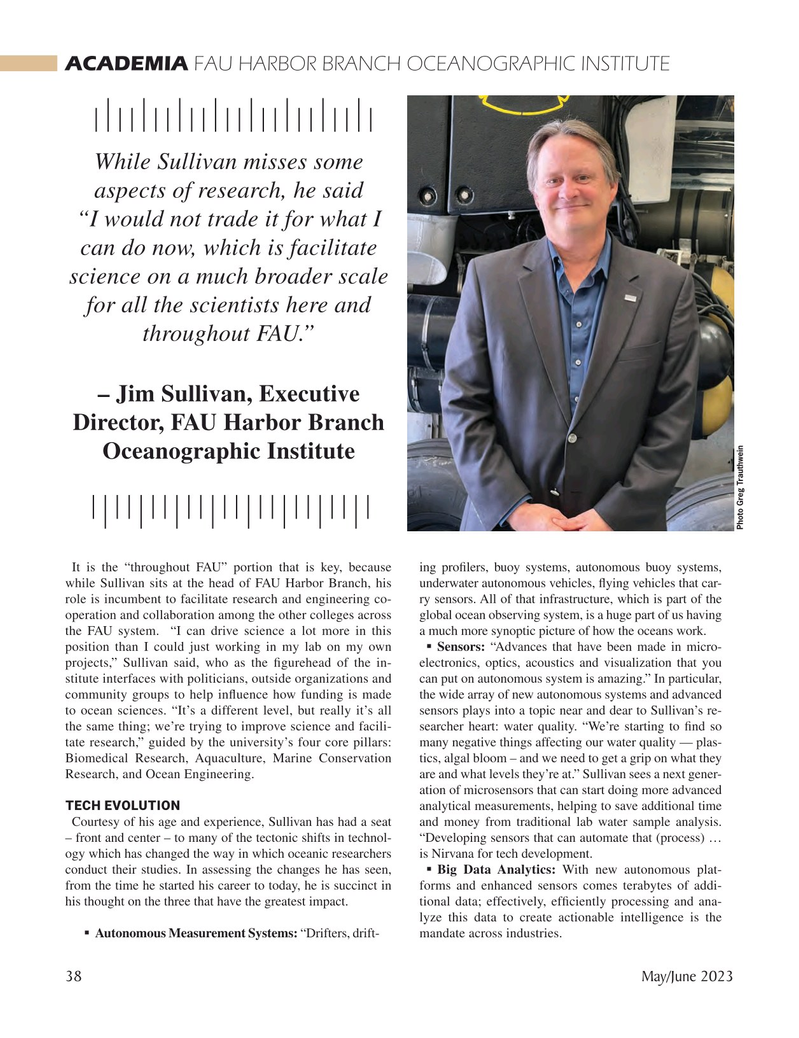
Page 38: of Marine Technology Magazine (May 2023)
Read this page in Pdf, Flash or Html5 edition of May 2023 Marine Technology Magazine
ACADEMIA FAU HARBOR BRANCH OCEANOGRAPHIC INSTITUTE
While Sullivan misses some aspects of research, he said “I would not trade it for what I can do now, which is facilitate science on a much broader scale for all the scientists here and throughout FAU.” – Jim Sullivan, Executive
Director, FAU Harbor Branch
Oceanographic Institute
Photo Greg Trauthwein
It is the “throughout FAU” portion that is key, because ing pro? lers, buoy systems, autonomous buoy systems, while Sullivan sits at the head of FAU Harbor Branch, his underwater autonomous vehicles, ? ying vehicles that car- role is incumbent to facilitate research and engineering co- ry sensors. All of that infrastructure, which is part of the operation and collaboration among the other colleges across global ocean observing system, is a huge part of us having the FAU system. “I can drive science a lot more in this a much more synoptic picture of how the oceans work. position than I could just working in my lab on my own ?Sensors: “Advances that have been made in micro- projects,” Sullivan said, who as the ? gurehead of the in- electronics, optics, acoustics and visualization that you stitute interfaces with politicians, outside organizations and can put on autonomous system is amazing.” In particular, community groups to help in? uence how funding is made the wide array of new autonomous systems and advanced to ocean sciences. “It’s a different level, but really it’s all sensors plays into a topic near and dear to Sullivan’s re- the same thing; we’re trying to improve science and facili- searcher heart: water quality. “We’re starting to ? nd so tate research,” guided by the university’s four core pillars: many negative things affecting our water quality — plas-
Biomedical Research, Aquaculture, Marine Conservation tics, algal bloom – and we need to get a grip on what they
Research, and Ocean Engineering. are and what levels they’re at.” Sullivan sees a next gener- ation of microsensors that can start doing more advanced
TECH EVOLUTION analytical measurements, helping to save additional time
Courtesy of his age and experience, Sullivan has had a seat and money from traditional lab water sample analysis. – front and center – to many of the tectonic shifts in technol- “Developing sensors that can automate that (process) … ogy which has changed the way in which oceanic researchers is Nirvana for tech development. conduct their studies. In assessing the changes he has seen, ?Big Data Analytics: With new autonomous plat- from the time he started his career to today, he is succinct in forms and enhanced sensors comes terabytes of addi- his thought on the three that have the greatest impact. tional data; effectively, ef? ciently processing and ana- lyze this data to create actionable intelligence is the ?Autonomous Measurement Systems: “Drifters, drift- mandate across industries. 38 May/June 2023
MTR #4 (34-47).indd 38 6/1/2023 9:19:03 AM

 37
37

 39
39
